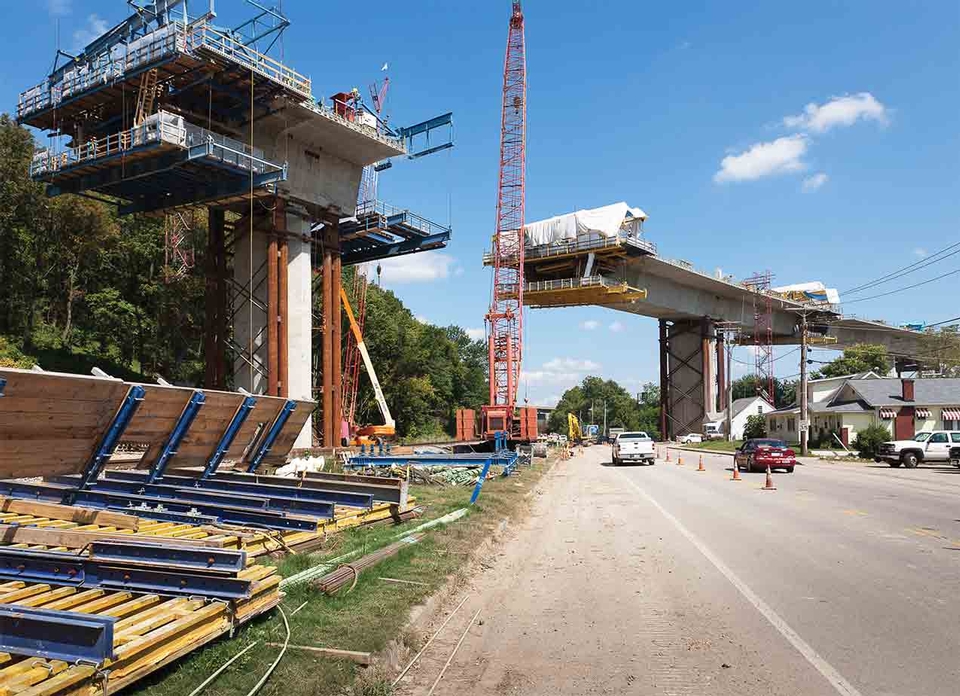I-64 Kanawha River Bridge – Kanawha County, West Virginia
The innovative Kanawha River Bridge is a record-setting (760-foot main span), low cost, durable and aesthetically pleasing segmental box girder structure built as part of the I-64 Widening Project in Kanawha County, West Virginia. The bridge carries I-64 eastbound traffic consisting of three through lanes, one auxiliary lane, and shoulders. The overall bridge length is 2,975 feet, including a record 760-foot main span. The superstructure was built using the balanced cantilever construction method with cast-in-place segments supported by form travelers. Bridge construction was completed ahead of schedule and the structure was opened to traffic for the first time on July 31, 2010.
The Kanawha River Bridge designers were confronted with the challenge of designing a 2,975-foot long eastbound structure for the new alignment. The requirement to locate the main piers outside the main channel of the Kanawha River dictated a 760-foot main span. The span arrangement studies included five different alternatives for this river crossing. Detailed evaluations considering aesthetics, constructability, cost, and maintenance requirements resulted in the selection of the segmental concrete box girder alternative for the final design.
Innovation of Design and/or Construction
The Kanawha River Bridge designers employed a combination of existing segmental bridge technologies and innovative approaches to solve the challenges of this complex project with a scale larger than usual. Since barges use the river regularly, the structure had to span the entire waterway in order to avoid obstructions to navigation, thus resulting in the longest box girder span in the United States.
The 66-foot wide bridge section is a slender single cell box girder with 1 foot 6 inch thick webs, 16-foot long cantilever overhangs and structural depth varying between 38 and 16 feet. This section is more slender and lighter than traditional concrete box designs and utilizes the construction materials to their full potential. The highway alignment with circular curves, spiral transitions, and a super elevation varying from minus 8% to plus 8%, made the definition of pier geometry and the form travelers details more complex than usual.
This 2,975 foot continuous structure was designed to have expansion joints at the abutments only. The advantages of this groundbreaking design are to reduce maintenance, improve ride ability, and simplify construction, as intermediate hinges are not needed. In order to address the potentially large transverse displacements due to creep, shrinkage, and temperature changes on a curved alignment, the designers used the innovative approach of setting bearing restraints in the radial direction and designed piers and abutments for the resulting radial forces.
Rapid Construction
The superstructure was built overhead with minimal impact to the public by using two pairs of form travelers supporting the cast-in-place segments, resulting in an efficient construction cycle reaching peak production rates of four segments per week. Segment construction continued during the winter although some concrete pours during winter months required external heat application.
Aesthetics and/or Harmony with the Environment
The superstructure cross-section, with long overhangs and inclined webs, results in a light appearance. The shadow created by the overhangs reduces the perceived superstructure depth. The inclination of the webs lessens the volume of the superstructure. The curved approach spans give a sense of openness and continuity with the graceful main span. The edges of the main span piers embrace the webs of the superstructure, thus subdividing the box girder depth. The piers have a modified rectangular section, with 45-degree chamfers, which reduces the perceived width of the columns in skewed views. The transverse faces of all piers and abutments have a textured architectural treatment. An applied concrete finish was used on all the surfaces of substructure and superstructure elements.
Environmental and public impact was minimized by the use of cast-in-place long span balanced cantilever construction. The use of post-tensioned concrete and the expected long design life bring significant sustainability benefits. With the completion of the project, traffic congestion and the pollution associated with congestion have been minimized.
Cost Competitiveness
The advertisement of the Kanawha River Bridge included two bridge alternatives. Competitive bidding of steel versus concrete alternatives was used to determine the most economical solution. The bid price for the segmental concrete bridge alternative was $82.9 million, $30 million less than a competing alternative. Considering bridge items only, the bid price of the segmental concrete box girder bridge was $75 million. This represents an average cost of $379 per square foot, a very competitive cost considering the long bridge spans.
Minimization of Construction Impact on the Traveling Public
Site constraints such as the existing residential and commercial properties, three local roads, a railroad track, and the Kanawha River waterway traffic, were addressed with long span balanced cantilever construction. The superstructure was built overhead with minimal impact to the public with two pairs of form travelers supporting the cast-in-place segments.
Jury Comments
The project incorporates concrete segmental bridge technology to produce a record main span over water to avoid obstructions to the river barge traffic. The use of expansion joints at the abutments was innovative and improves ride ability for the traveling public while reducing the bridge’s long-term maintenance needs.
2011 ASBI Bridge Award of Excellence
Category: Bridges Over Water
State:
West Virginia
Owner:
West Virginia Department of Transportation, Division of Highways
Owner’s Engineers:
T.Y. Lin International
Designer:
T.Y. Lin International
Geotechnical Subconsultant:
Triad Engineering, Inc.
Contractor:
Brayman Construction Corporation
Construction Engineering Services:
Finley Engineering Group, Inc. and Michael Baker Jr., Inc.
Construction Inspection:
West Virginia Department of Transportation, Division of Highways
Concrete Supplier:
Arrow Concrete
Formwork for Cast-in-Place Segments:
Doka USA, Ltd.
Form Travelers for Cast-in-Place Segments:
STRUKTURAS
Post-Tensioning Materials:
VSL
Bearings:
R.J. Watson, Inc.
Expansion Joints:
Watson Bowman Acme Corporation
Prepackaged Grout:
BASF






